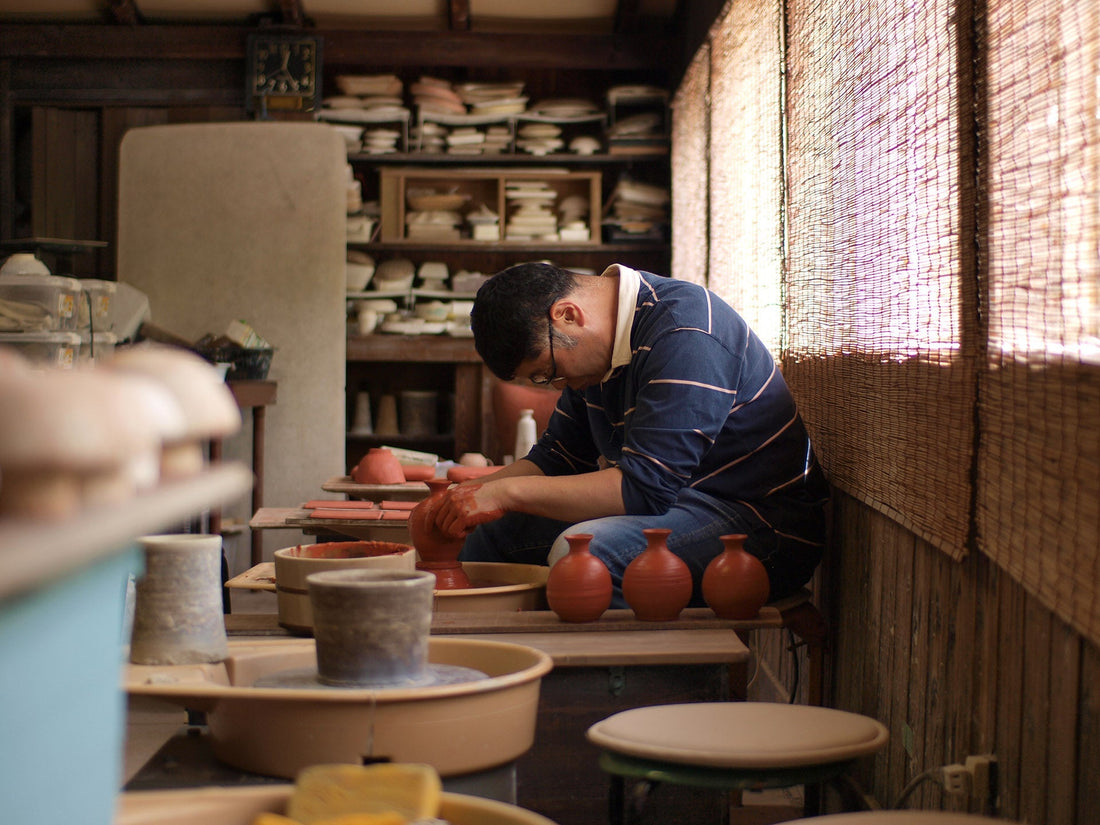
Interview with Keisuke Wakao of Kokei Kiln
Keep seeking, keep creating, keep expressing until you die.
-Works that contain surprise and innovation even in the midst of the ordinary
Profile/Ceramics history
(Wakao Keisuke)
Born in Tajimi City in 1969. Studied sculpture at the University of Tsukuba, and after completing graduate school, began making pottery with his predecessor at Kokei Kiln.
(Award history as of 2025)
He has been selected for the Asahi Ceramic Art Exhibition five times and the Free Art Exhibition three times. In 2003, he won the Mino Ceramic Art Grand Prize at the Mino Ceramic Art Exhibition.

Kokei Kiln is located on a hill overlooking the cityscape of Tajimi, Gifu Prefecture, known for its Mino ware. Away from the hustle and bustle of the city, in a quiet mountain setting, Kokei Kiln is a facility and studio where you can experience pottery making, relocated from Niigata to this over 200-year-old traditional Japanese house. We spoke to Wakao Keisuke, the second-generation potter who continues to create pottery, about his journey as a potter, his thoughts on pottery making, and the appeal of it.

At the workshop, which was relocated from a 200-year-old traditional Japanese house, you can purchase works from Kokei Kiln.
Learning the fundamentals of three-dimensional sculpture, which led to his current style
Keisuke was born as the eldest son of a pottery owner. His father, the previous owner, Masahiro, told him, "Just follow the path you like," and he hadn't given the slightest thought to following in his footsteps. Just when he was starting to think about going to university, the previous owner asked him to take over the business.
Keisuke recalls, "It was like he suddenly turned his back on me." They argued, but when he thought about it calmly , he realized that he didn't have anything he wanted to do that would go against his parents' wishes, and that he didn't have a clear vision for the future, so he decided to take over the kiln himself. "I think my father couldn't bear to see me doing so poorly in school at the time," he says with a laugh.
Keisuke's first step as a ceramic artist was to study sculpture at the University of Tsukuba. He thoroughly pursued modeling, and the "craftsmanship" he learned over the six years he spent studying there, from undergraduate to graduate school, has had a major influence on his current style. Although the materials were different, he says that the focus on creating a three-dimensional object and the visual training in seeing shapes had something in common with ceramics.
The beginning of training at Kokei Kiln and the days of confusion
After graduating from graduate school, Keisuke began working at Kokei Kiln alongside his predecessor. Looking back on that time, he says, "I had no idea what I was doing."
Although he felt that there was a lot to do in his job, he was rarely entrusted with other tasks, and there were days when he felt bored. Although he felt anxious and dissatisfied with the previous owner's teachings of "watch and learn," he continued working and was able to create his own works after about one to two years.

Keisuke's works have an impact as three-dimensional objects due to their size, and the delicate texture of their colors and textures further enhances their perfection as works.
With the encouragement of those around him, he joined the Mino Ceramic Art Association and submitted a piece that is currently on display at the entrance to the museum to the Mino Ceramic Art Exhibition, where it won an Encouragement Award. Winning an award after just two or three years of experience as a ceramic artist may seem like a good start, but Keisuke's feelings were different to those of those around him. He continued to actively submit his work to public exhibitions, but was selected but never won a prize. Looking back, he says, "I didn't have much stored up inside me, so I was working hard to come up with ideas." He also says he continued to search for his own style and was lost.

Keisuke says he was always searching for his own style and pursuing ideas.
The establishment of a unique style that began with a chance discovery
While Keisuke works on traditional Mino ware, he always felt that if he tried to imitate it, it would clearly show in his work, so he always approached pottery making with the thought that "I have to change something from what my predecessors are doing."
One day, when he put a red clay piece into his father's kiln, it unexpectedly turned out a pale green, and Keisuke was captivated by the finished product. This coincidence led to the establishment of Keisuke's current style.


We have further researched red clay and are making our own adjustments to suit the finished product.
Keisuke felt that "until then I hadn't been as particular about clay as other artists," but one day, he came across red clay and was fascinated by the changing color of the clay, which led him to continue his research. He began working on a technique called cooling reduction, which causes the iron in the clay to undergo a chemical reaction, resulting in a black carbonization firing.
Regarding the red clay to use, I came to the conclusion that the best way to achieve better results is to use the leftover clay from my parents' kiln. I have been adding iron to clay that would have been discarded up until now, making it easier to use and using it in my pottery making.
He also continues to pursue changes in color. "When I spray glaze onto the surface of a piece with a compressor and then apply glazing on top of that, blue overlaps with light green, and the areas that are not glazed turn out black. The difference in color is fascinating," he says, and he has been working on this for decades.
Found "freedom" in the "restrictions" of pottery
Keisuke describes his style as " normal, not eccentric ," and aims to create "breakthrough works that go beyond the ordinary."
"Ceramics has many limitations in terms of the materials. But you find freedom in finding something within those limitations and creating a work. That's what ceramics is," says Keisuke.
Behind his gentle manner of speaking and humble personality, I sensed a strong passion for pottery making. During the interview, he said, "I will continue to seek, create, and express until I die," and I could sense the passion that Keisuke harbors deep within.

(June 2024, Interview: Chika Shimura)
information
Kokeigama
2-29 Sumiyoshicho, Tajimi City, Gifu Prefecture, 507-0015
Tel: 0572-22-0129




